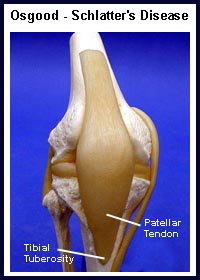This section covers Osgood-Schlatter’s Knee Pain (or Osgood-Schlatter’s Disease) that occurs as a result of overuse (“too much activity, too soon”). In order to better understand Osgood-Schlatter’s Knee Pain, it is important to understand the anatomy and function of the knee and the patellar tendon. Please review the section on knee anatomy before reviewing this section.

The patellar tendon is a thick rope-like structure that connects the bottom of the kneecap (patella) to the top of the large shin bone (tibia). The powerful muscles on the front of the thigh, the quadriceps muscles, straighten the knee by pulling at the patellar tendon via the patella. OSKP is caused by inflammation (irritation) where the patellar tendon attaches to the tibia.
Osgood-Schlatter’s Knee Pain (OSKP), also known as Osgood-Schlatter’s disease, is common in rapidly growing, active young teenagers and pre-teenagers. Pain from OSKP is usually felt 2-3 finger-widths below the bottom of the patella. There may be swelling in the area and it can be sensitive to touch. The pain can be mild or in some cases, the pain can be so bad that it prevents athletes from playing their sport.
What causes Osgood-Schlatter’s Disease?
OSKP usually occurs as a result of overdoing an activity and placing too much stress on growing bones. Activities that include a lot of running, jumping or stopping and starting can make OSKP worse. OSKP can be prevented by easing into these types of activities and by using good training techniques. Off-season strength training of the legs, particularly the quadriceps muscles, can also help.
How do you diagnose Osgood-Schlatter’s Disease?
Examination techniques that detect tenderness and swelling at the attachment site of the patellar tendon to the tibia are helpful in determining if someone has OSKP. X-rays are occasionally done to make sure that the patellar tendon does not have any calcium in it. Other tests such as diagnostic ultrasound or Magnetic Resonance Imaging (MRI) are rarely required to rule out more extensive damage to the patellar tendon.
What is the treatment for Osgood-Schlatter’s Disease?
The treatment of OSKP may include relative rest, icing, medications to reduce inflammation and pain, stretching and strengthening exercises. Rarely is complete rest or the use of a knee brace or cast necessary. Sometimes OSKP will even go away on it’s own. Doctors and physiotherapists trained in treating this type of overuse injury can outline a treatment plan specific to each individual.
Please visit the links section for additional information on Osgood-Schlatter’s Knee Pain. Links have been provided to other websites as well as online medical journals. Other knee injury topics can also be accessed.
